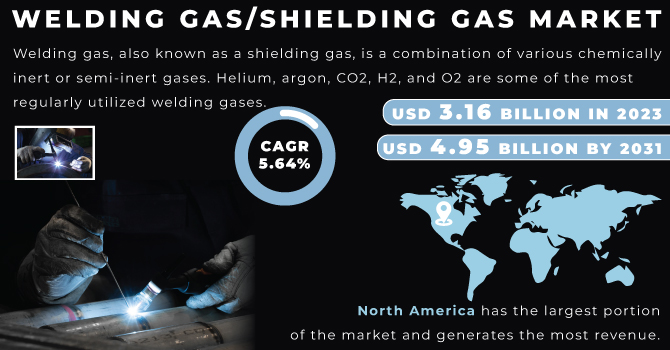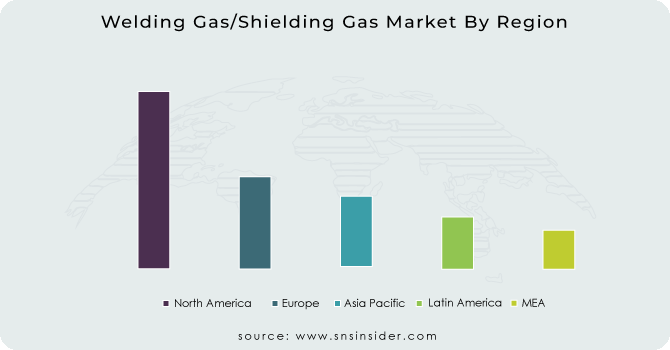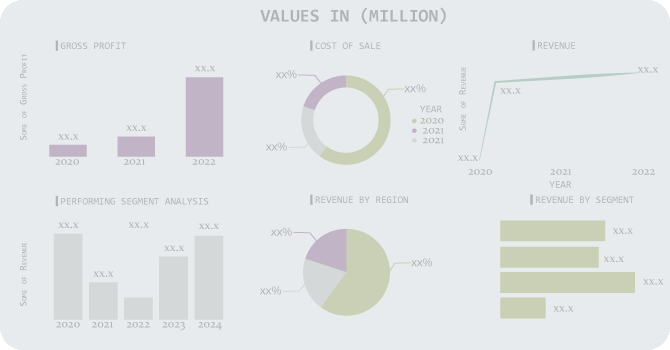Welding Gas/Shielding Gas Market Report Scope & Overview:
Welding Gas/Shielding Gas Market size was valued at USD 3.16 Bn in 2023 and is expected to reach USD 4.95 Bn by 2031 With a growing CAGR of 5.64 % over the forecast period 2024-2031.
Welding gas, also known as a shielding gas, is a combination of various chemically inert or semi-inert gases. Helium, argon, CO2, H2, and O2 are some of the most regularly utilized welding gases. Welding gas protects the welding area from moisture and other ambient gas mixes, which is important in commercial welding. Various gases in the environment react with the welding material during the welding process, resulting in issues such as poor weld quality, porosity, and other issues. Different welding methods, such as laser welding, oxy-fuel welding, metal arc welding, and others, use welding gases. Welding gas, also known as a shielding gas, is a mixture of inert and semi-inert gases used to protect welds from dangerous gases in the environment. These gases are known as Nobel gases and are colorless, odorless, and chemically inert. Welding is a technique for uniting two or more metals that are similar or not comparable by heating them below their melting point. This method is widely utilized in the construction industry, as well as in a variety of other fields. Many items would not have operated without welding or shielding. However, welding or shielding requires gas, which is critical to its success. With the growing need for welding and shielding, the worldwide welding gas market is quickly expanding.

To get more information on Welding Gas/Shielding Gas Market - Request Free Sample Report
MARKET DYNAMICS:
KEY DRIVERS:
-
Increasing demand for welding processes in the construction sector.
-
Government initiatives for developing better Infrastructure.
-
Governments rising interest in investment in mining development.
RESTRAINTS:
-
Welding gas/shielding gas is explosive.
-
Making process of these gas is complicated and increases the cost of welding.
OPPORTUNITY:
-
Continuous efforts of government in infrastructure development.
-
The rise in the automotive industry and many nations focusing on automotive production.
-
Rise of people's interest in investing in the construction business
CHALLENGES:
-
Complicated production process.
-
Risk of explosion.
IMPACT OF COVID-19:
Many companies and economies throughout the world have been badly impacted by the covid-19 epidemic. Many firms encountered financial difficulties as a result of the virus's lockdown in many nations, and manufacturing activities came to a standstill. Construction and manufacturing were two of the most heavily impacted industries. Construction and industrial production had ceased throughout the world, and the car industry had suffered significant losses as a result of the covid-19 epidemic. The new vehicle's production was halted, and the automobile sector was shut down internationally owing to a manpower shortage and lockout. People were experiencing a financial crisis, therefore they did not invest in automobiles or building activities. The market was severely impacted by all of these reasons. In the year 2021, the market value was $2.90 billion because of the covid-19 pandemic. Following the Covid-19 scenario, the market will witness favorable development. The market's major participants were instrumental in driving up demand.
MARKET ESTIMATION:
The market is divided into four types Argon, Carbon dioxide, Oxygen, Hydrogen, and Others. The Argon category now holds the largest market share and is predicted to expand significantly and continue to dominate the worldwide market over the forecast period. The market is divided into Metal Manufacturing, Construction, Energy, Aerospace, and Others, according to the end-user. In the worldwide market, the Metal Manufacturing component has the biggest market share and is expected to develop rapidly throughout the projected period. The Segment focuses on each application's current position and potential for substantial application value, market share, and growth valuation. Based on the application the market is fragmented into Gas Tungsten Arc Welding, Gas Metal Arc Welding Others (Oxy-Acetylene Welding).
KEY MARKET SEGMENTATION
By Type
-
Argon
-
Hydrogen
-
Carbon dioxide
-
Oxygen
-
Others
By Storage, Transportation and Distribution Mode
-
Cylinder & Packaged Gas Distribution
-
Merchant Liquid/bulk Distribution
By Application
-
Gas metal arc welding
-
Gas tungsten arc welding
-
Others
By End-Use Industry
-
Metal Manufacturing & Fabrication
-
Aerospace
-
Construction
-
Energy
-
Others
REGIONAL ANALYSIS:
North America, Europe, Asia Pacific, and the rest of the globe are the regions covered in the Welding gas/shielding gas market. North America has the largest portion of the market and generates the most revenue. The market in this region is being driven by a stable and healthy economy as well as rising building demand. Asia Pacific is increasing at the quickest pace, with the greatest CAGR projected during the projection period. China, Japan, and India are all contributing to the market's expansion. The region's market expansion is being fueled by government measures to improve infrastructure and a growing economy. The European area is likewise seeing substantial market expansion. In this area, the automotive sector is quickly developing, and the rising demand for innovative automobiles will propel the market forward in the future years.

Need any customization research on Welding Gas/Shielding Gas Market - Enquiry Now
REGIONAL COVERAGE:
-
North America
-
US
-
Canada
-
Mexico
-
-
Latin America
-
Brazil
-
Argentina
-
Colombia
-
Rest of Latin America
-
Middle East & Africa
-
Middle East
-
UAE
-
Egypt
-
Saudi Arabia
-
Qatar
-
Rest of the Middle East
-
-
Africa
-
Nigeria
-
South Africa
-
Rest of Africa
-
-
-
India
-
Japan
-
South Korea
-
Vietnam
-
Singapore
-
Australia
-
Rest of Asia Pacific
Asia Pacific
-
-
China
-
Europe
-
Eastern Europe
-
Poland
-
Romania
-
Hungary
-
Turkey
-
Rest of Eastern Europe
-
-
Western Europe
-
Germany
-
France
-
UK
-
Italy
-
Spain
-
Netherlands
-
Switzerland
-
Austria
-
Rest of Western Europe
-
-
KEY PLAYERS:
The major key players in these markets are Air Liquide S.A., Air Products, Gulf Cryo, Iwatani Corporation, Messer Group, Praxair Inc., Southern Industrial Gas, Taiyo Nippon Sanso Corporation, The Linde Group and Other In the final Report.
Air Products-Company Financial Analysis

| Report Attributes | Details |
|---|---|
| Market Size in 2023 | US$ 3.16 Billion |
| Market Size by 2031 | US$ 4.95 Billion |
| CAGR | CAGR of 5.64% From 2024 to 2031 |
| Base Year | 2022 |
| Forecast Period | 2024-2031 |
| Historical Data | 2020-2021 |
| Report Scope & Coverage | Market Size, Segments Analysis, Competitive Landscape, Regional Analysis, DROC & SWOT Analysis, Forecast Outlook |
| Key Segments | • By Type (Argon, Hydrogen, Carbon dioxide, Oxygen, Others) • By Storage, Transportation and Distribution Mode (Cylinder & Packaged Gas Distribution, Merchant Liquid/bulk Distribution) • By Application (Gas metal arc welding, Gas tungsten arc welding, Others) • By End-Use Industry (Metal Manufacturing & Fabrication, Aerospace, Construction, Energy, Others) |
| Regional Analysis/Coverage | North America (US, Canada, Mexico), Europe (Eastern Europe [Poland, Romania, Hungary, Turkey, Rest of Eastern Europe] Western Europe] Germany, France, UK, Italy, Spain, Netherlands, Switzerland, Austria, Rest of Western Europe]), Asia Pacific (China, India, Japan, South Korea, Vietnam, Singapore, Australia, Rest of Asia Pacific), Middle East & Africa (Middle East [UAE, Egypt, Saudi Arabia, Qatar, Rest of Middle East], Africa [Nigeria, South Africa, Rest of Africa], Latin America (Brazil, Argentina, Colombia, Rest of Latin America) |
| Company Profiles | The major key players in these markets are Air Liquide S.A., Air Products, Gulf Cryo, Iwatani Corporation, Messer Group, Praxair Inc., Southern Industrial Gas, Taiyo Nippon Sanso Corporation, The Linde Group and Other In the final Report. |
| Key Drivers | •Increasing demand for welding processes in the construction sector. •Government initiatives for developing better Infrastructure. |
| Restraints | •Welding gas/shielding gas is explosive. •Making process of these gas is complicated and increases the cost of welding. |

